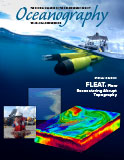Article Abstract
The interaction of flow with steep island and ridge topography at the Palau island chain leads to rich vorticity fields that generate a cascade of motions. The energy transfer to small scales removes energy from the large-scale mean flow of the equatorial current systems and feeds energy to the fine and microstructure scales where instability mechanisms lead to turbulence and dissipation. Until now, direct assessments of the turbulence associated with island wakes have received only minimal attention. Here, we examine data collected from an ocean glider equipped with microstructure sensors that flew in the island wake of Palau. We use a combination of submesoscale modeling and direct observation to quantify the relationship between vorticity and turbulence levels. We find that direct wind-driven mixing only accounts for about 10% of the observed turbulence levels, suggesting that most of the energy for mixing is extracted from the shear associated with the vorticity field in the island’s wake. Below the surface layer, enhanced turbulence correlates with the phase and magnitude of the relative vorticity and strain levels of the mesoscale flow.

